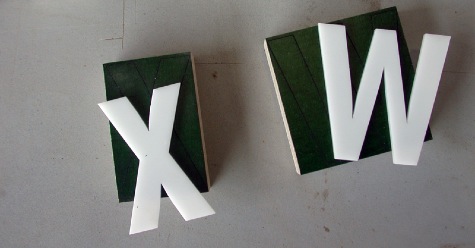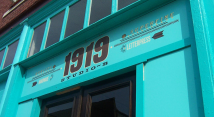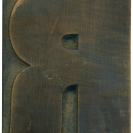11.16.09
I‘ve always wondered why more research hasn’t been done on alternative methods for creating movable type. Photopolymer plates have done a lot in the way of breathing new life into letterpress and giving printers more options. But at some point, the already limited amounts of wood type that remain are going to wear down or become so fragile that they have to be retired.
This fall I started research on possible methods of creating new movable type. The advantages of creating new blocks, as opposed to plates, would be the modularity of individual letters and the ability to set type without the need for a special base. The type would need to be durable and print at least as well as wood type. The solution I and my professor settled upon would be to use a thin material for the face of the letters, something that could be lasercut, and to mount it to a base that would bring the face to type height. We ended up using an acrylic for the faces, and a thick plywood for the slugs.
We started off trying to complete a set of Futura condensed that was missing several characters. We set up vector files with the reversed outlines of the characters we needed, then set up a separate file to etch into the plywood. To ensure that the letter would have an even baseline on the slugs, that there wouldn’t be an extraneous space on the sides, and the letters would be glued straight, we laser cut the outlines of each letter and cut the guidelines for the slugs into the plywood. The plywood was then sliced to create the slugs, then the acrylic was glued into the appropriate piece of wood.













kvh
Bethany – this is really great and very inspirational.
Any chance you would part with some of the details on this? Plexi thickness and particulars on plywood? I think I have most of the necessary tools at my disposal at the school I work for.
and P.S. – I’m about to include you on a post here: http://www.baltimoreprintstudios.com
02-15-10 » 6:59 pm »
melanie
Why did you opt to attach the plexi to the plywood? Since you lasered an outline on the plywood, why not just leave a raised letter on the plywood? I do not know much about laser cutters and their limitations- can you expand on your process?
04-06-10 » 5:40 pm »
Bethany Heck
Melanie, etching into plywood is both more expensive and creates more airborne waste, because you have to burn away the shoulder area instead of just cutting it out. It would also be much harder to get plywood at type height, it would need to be planed down. There is also the issue of the plywood not being hard enough to make a good block. It would quickly wear down.
Does that answer your questions? The combination of materials made for a type high block that had a hard printing surface and didn’t put too much ash and debris into the air that is both unhealthy and risks damaging the laser cutter.
04-06-10 » 9:40 pm »
melanie
Thanks for the response. I know of new produced wood type made with endgrain and flatgrain blocks- cherry, i think. I suspect they are made with a laser cutter rather than router or die.
04-07-10 » 6:43 pm »
Patrick G Clark
Hi Bethany,
Whenever I’ve cut chip board with the laser cutter, I have to clean the edges thoroughly with a grey gummy eraser or a paper towel.
Do you have to do the same with plexi?
05-31-10 » 3:41 pm »
Bethany Heck
Patrick,
While we’ve had occasional areas that didn’t quite cut all the way through, they are few and far between, we’ve never had to do any significant cleaning after cutting plexi.
05-31-10 » 6:37 pm »
yovrup
yovrup b0da67c006 https://marketplace.visualstudio.com/items?itemName=1sanecube.LINK-Aveva-Pdms-121-Sp4-Crack
04-07-22 » 4:39 pm »
travlinc
travlinc a60238a8ce https://coub.com/stories/4887226-dragon-s-hoard-2021
04-21-22 » 5:38 am »
rebepet
rebepet a60238a8ce https://coub.com/stories/4886947-gates-of-devoroth-2021
04-21-22 » 10:26 am »
kayjam
kayjam baf94a4655 https://coub.com/stories/4928989-noir-punk-version-pirateada
04-22-22 » 2:28 pm »
marihee
marihee baf94a4655 https://coub.com/stories/4905096-emporea-realms-of-war-and-magic-version-pirateada
04-22-22 » 4:45 pm »
carjos
carjos baf94a4655 https://coub.com/stories/4959394-descargar-escape-from-the-dragons-gratuita
04-22-22 » 7:10 pm »
peawyll
peawyll baf94a4655 https://trello.com/c/qLc4BRg0/54-descargar-kris-kringles-christmas-village-vr-versi%C3%B3n-pirateada-2021
04-22-22 » 9:35 pm »
leyjame
leyjame baf94a4655 https://coub.com/stories/4959950-descargar-soobmarinno-version-pirateada-2021
04-23-22 » 12:09 am »
philtam
philtam baf94a4655 https://coub.com/stories/4907172-descargar-cold-verdict-gratuita
04-23-22 » 3:02 am »
rainind
rainind baf94a4655 https://coub.com/stories/4916650-ul-version-completa-2021
04-23-22 » 5:25 am »
hetwili
hetwili baf94a4655 https://trello.com/c/q6NfM2DA/47-descargar-thunderballs-vr-versi%C3%B3n-completa-2022
04-23-22 » 12:48 pm »
daripol
daripol baf94a4655 https://coub.com/stories/4935322-descargar-love-engine-version-completa-gratuita-2022
04-23-22 » 5:36 pm »
raycia
raycia baf94a4655 https://coub.com/stories/4899111-deltaplan-simulator-gratuita-2022
04-23-22 » 7:57 pm »
lavymar
lavymar baf94a4655 https://coub.com/stories/4917974-descargar-rags-to-dishes-version-completa-gratuita
04-23-22 » 10:16 pm »
gidecrei
gidecrei baf94a4655 https://trello.com/c/avCCPShh/79-descargar-beholders-lair-versi%C3%B3n-pirateada-2022
04-24-22 » 12:29 am »
silvnai
silvnai baf94a4655 https://coub.com/stories/4905438-descargar-unseen-gratuita
04-24-22 » 2:39 am »
javowhy
javowhy baf94a4655 https://coub.com/stories/4940714-descargar-abyssus-version-pirateada
04-24-22 » 4:55 am »
agrchri
agrchri baf94a4655 https://trello.com/c/qMU9gygc/41-descargar-cat-slide-tiles-versi%C3%B3n-completa-gratuita
04-24-22 » 7:31 am »
davicoll
davicoll baf94a4655 https://trello.com/c/VDIkaXsO/72-descargar-notruf-112-emergency-call-112-gratuita
04-24-22 » 9:48 am »
ondgher
ondgher baf94a4655 https://trello.com/c/3v58lOXS/90-choice-of-life-middle-ages-versi%C3%B3n-completa-gratuita
04-24-22 » 12:02 pm »
ginneya
ginneya baf94a4655 https://trello.com/c/DZQ8y9EC/43-descargar-virago-gratuita
04-24-22 » 2:10 pm »
dejmalv
dejmalv baf94a4655 https://coub.com/stories/4950364-descargar-super-brain-cube-version-completa-gratuita-2022
04-24-22 » 8:38 pm »
bencor
bencor fe9c53e484 https://coub.com/stories/4918712-mythic-legions-tactics-version-pirateada-2022
04-25-22 » 11:17 am »
talmpap
talmpap fe9c53e484 https://coub.com/stories/4933856-descargar-last-chickenburg-version-completa-gratuita
04-25-22 » 12:56 pm »
salvceli
salvceli fe9c53e484 https://coub.com/stories/4919008-descargar-pixel-art-workshop-gratuita-2021
04-25-22 » 2:35 pm »
banmanf
banmanf fe9c53e484 https://trello.com/c/n7phA8vV/63-defenders-glory-versi%C3%B3n-pirateada-2021
04-25-22 » 4:14 pm »
colipeit
colipeit fe9c53e484 https://coub.com/stories/4930029-descargar-captures-ii-version-pirateada-2022
04-25-22 » 9:14 pm »
ellgaet
ellgaet f6d93bb6f1 https://coub.com/stories/4962011-walmart-is-latest-nulled-full-version-zip-x64
04-29-22 » 4:22 pm »
holalori
holalori f6d93bb6f1 https://coub.com/stories/5022259-download-the-wailing-wailers-at-studio-one-video-watch-online-avi-720p-dubbed
04-29-22 » 10:42 pm »
gilbyous
gilbyous f6d93bb6f1 https://coub.com/stories/4850726-gary-moore-s-windows-free-utorrent-keygen-ultimate
04-30-22 » 12:07 am »
makatake
makatake f6d93bb6f1 https://coub.com/stories/4850247-les-chevaliers-du-ciel-2005-4k-download-download-avi-full
04-30-22 » 1:33 am »
laulral
laulral 00291a3f2f https://trello.com/c/s51exBoq/59-download-instahack-instagram-account-password-hacking-tools-v3517-2022-for-android-full-verification-code
05-03-22 » 8:06 pm »
darladi
darladi 353a2c1c90 https://presevinas1970.wixsite.com/inatephol/post/domain-driven-design-eric-evans-ebook-pdf-51-giljali
05-16-22 » 10:03 am »
chevucm
chevucm 353a2c1c90 https://bancvecinutchitpbe.wixsite.com/rentgugvasig/post/intervideo-windvd-creator-30-keygen-13
05-16-22 » 11:13 am »